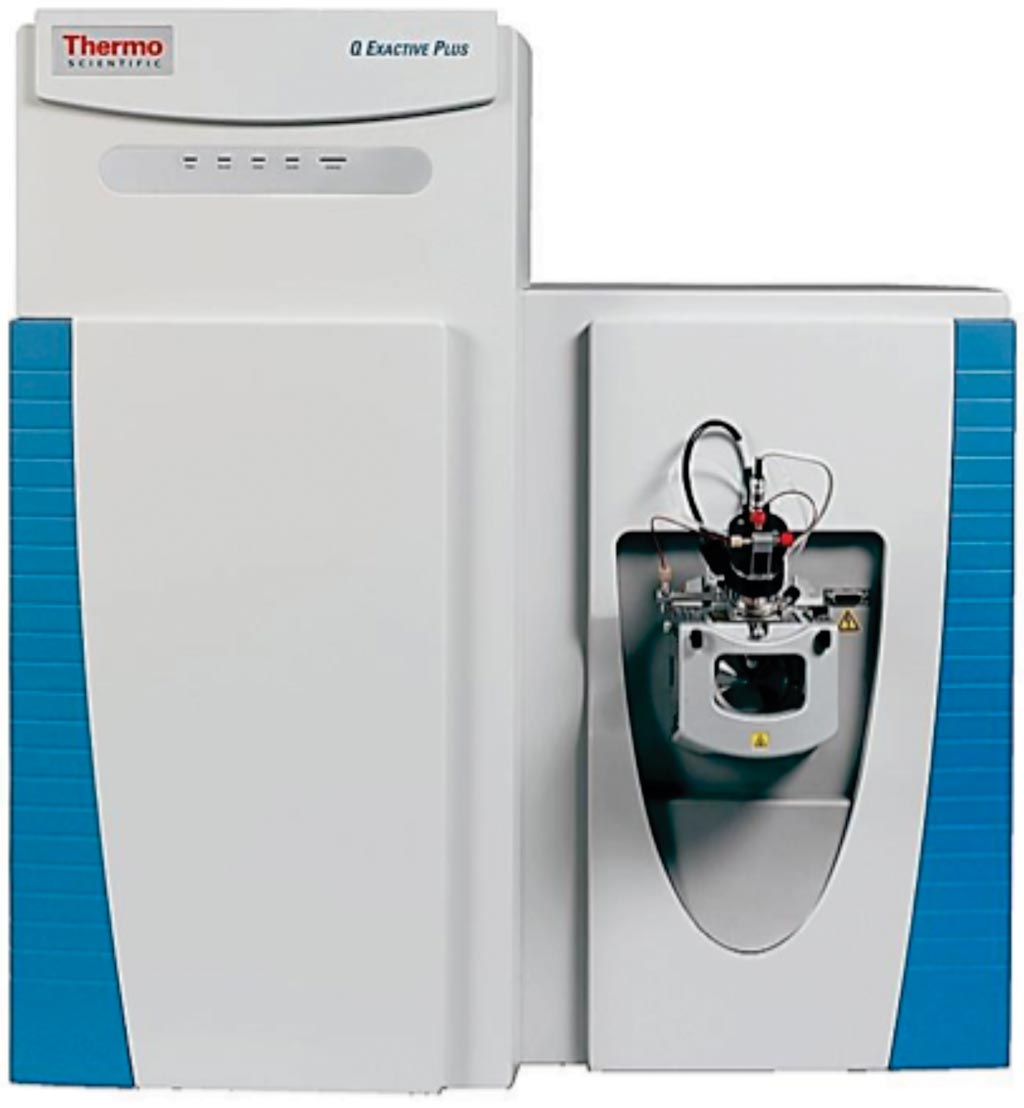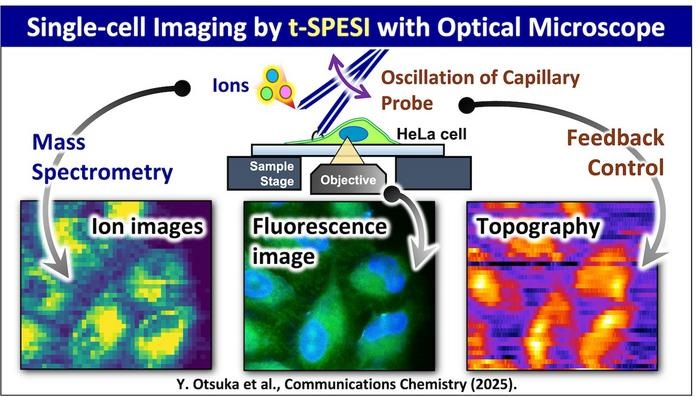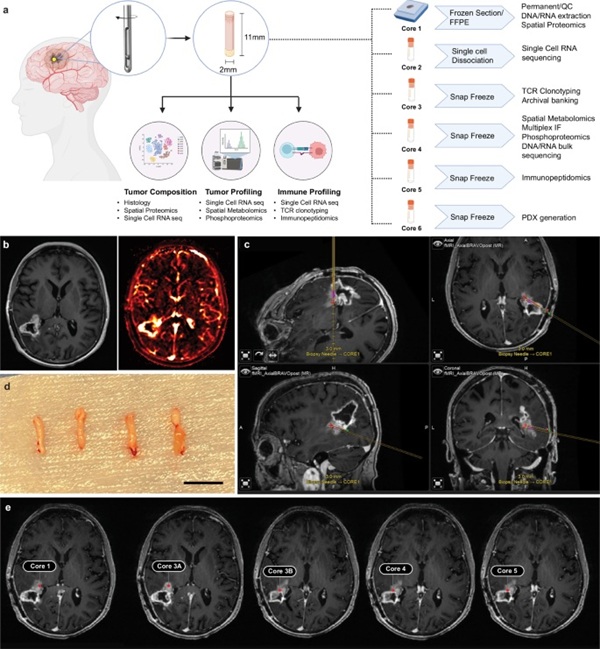Residual Tissue Repositories Suitable for MS-Based Proteomics
|
By LabMedica International staff writers Posted on 12 Sep 2018 |

Image: The Q Exactive hybrid quadrupole-orbitrap mass spectrometer (Photo courtesy of Thermo Fisher Scientific).
Mass spectrometry-based proteomics has become a powerful tool for the identification and quantification of proteins from a wide variety of biological specimens.
The majority of studies utilizing tissue samples have been carried out on prospectively collected fresh frozen or optimal cutting temperature (OCT) embedded specimens. However, such specimens are often difficult to obtain, in limited in supply, and clinical information and outcomes on patients are inherently delayed as compared to banked samples.
Scientists from the Pacific Northwest National Laboratory (Richland, WA, USA) and their colleagues analyzed 60 patient samples taken from the NCI's Surveillance, Epidemiology, and End Results (SEER) residual tissue repositories, which contain samples from more than 100,000 cancer patients, along with detailed demographic information, data on tumor characteristics, treatment, survival, and cause of death. The 60 samples ranged in their time of storage from seven to 32 years.
The team used 10-plex tandem mass tag (TMT) labeling and divided each sample into six fractions, each of which they then ran on a 100-minute nanoLC gradient upfront of analysis on a Q-Exactive Plus instrument. For phosphopeptide analysis, they used Immobilized Metal Affinity Chromatography (IMAC) enrichment. They found that all 60 samples provided sufficient material for proteome-wide protein expression analysis and 18 of the 60 samples provided enough material for phosphopeptide work.
The investigators identified and quantified a total of 8,582 proteins and 8,073 phosphopeptides across the SEER sample set, indicating that FFPE tissue is amenable to mass spec proteomics analysis. Protein identifications were reduced compared to the identifications possible in comparable optimal cutting temperature (OCT) compound-embedded specimens. Compared to OCT samples, peptide, protein, and phosphopeptide identifications were reduced by 50%, 20%, and 76%, respectively.
Karin D, Rodland, PhD, an expert in mass spectrometry and a senior author of the study, said, “There have been commercial kits available for 12 to 15 years for extracting proteins out of FFPE blocks, and on the face of it, the yields of protein from the FFPE blocks is not that bad. But with the mass spec technologies of 12 to 15 years ago, the rate of identification was very low. You just didn't get good [proteome] coverage out of FFPE blocks. And the assumption was that the formalin crosslinking was causing you to lose identifications. However, improvements in mass spec technology have provided instruments with higher sensitivity and better resolution that are capable of working with smaller amounts of sample.” The study was published on August 3, 2018, in the journal Clinical Proteomics.
Related Links:
Pacific Northwest National Laboratory
The majority of studies utilizing tissue samples have been carried out on prospectively collected fresh frozen or optimal cutting temperature (OCT) embedded specimens. However, such specimens are often difficult to obtain, in limited in supply, and clinical information and outcomes on patients are inherently delayed as compared to banked samples.
Scientists from the Pacific Northwest National Laboratory (Richland, WA, USA) and their colleagues analyzed 60 patient samples taken from the NCI's Surveillance, Epidemiology, and End Results (SEER) residual tissue repositories, which contain samples from more than 100,000 cancer patients, along with detailed demographic information, data on tumor characteristics, treatment, survival, and cause of death. The 60 samples ranged in their time of storage from seven to 32 years.
The team used 10-plex tandem mass tag (TMT) labeling and divided each sample into six fractions, each of which they then ran on a 100-minute nanoLC gradient upfront of analysis on a Q-Exactive Plus instrument. For phosphopeptide analysis, they used Immobilized Metal Affinity Chromatography (IMAC) enrichment. They found that all 60 samples provided sufficient material for proteome-wide protein expression analysis and 18 of the 60 samples provided enough material for phosphopeptide work.
The investigators identified and quantified a total of 8,582 proteins and 8,073 phosphopeptides across the SEER sample set, indicating that FFPE tissue is amenable to mass spec proteomics analysis. Protein identifications were reduced compared to the identifications possible in comparable optimal cutting temperature (OCT) compound-embedded specimens. Compared to OCT samples, peptide, protein, and phosphopeptide identifications were reduced by 50%, 20%, and 76%, respectively.
Karin D, Rodland, PhD, an expert in mass spectrometry and a senior author of the study, said, “There have been commercial kits available for 12 to 15 years for extracting proteins out of FFPE blocks, and on the face of it, the yields of protein from the FFPE blocks is not that bad. But with the mass spec technologies of 12 to 15 years ago, the rate of identification was very low. You just didn't get good [proteome] coverage out of FFPE blocks. And the assumption was that the formalin crosslinking was causing you to lose identifications. However, improvements in mass spec technology have provided instruments with higher sensitivity and better resolution that are capable of working with smaller amounts of sample.” The study was published on August 3, 2018, in the journal Clinical Proteomics.
Related Links:
Pacific Northwest National Laboratory
Latest Clinical Chem. News
- AI-Powered Blood Test Accurately Detects Ovarian Cancer
- Automated Decentralized cfDNA NGS Assay Identifies Alterations in Advanced Solid Tumors
- Mass Spectrometry Detects Bacteria Without Time-Consuming Isolation and Multiplication
- First Comprehensive Syphilis Test to Definitively Diagnose Active Infection In 10 Minutes
- Mass Spectrometry-Based Monitoring Technique to Predict and Identify Early Myeloma Relapse
- ‘Brilliantly Luminous’ Nanoscale Chemical Tool to Improve Disease Detection
- Low-Cost Portable Screening Test to Transform Kidney Disease Detection
- New Method Uses Pulsed Infrared Light to Find Cancer's 'Fingerprints' In Blood Plasma
- Carbon Nanotubes Help Build Highly Accurate Sensors for Continuous Health Monitoring
- Paper-Based Device Boosts HIV Test Accuracy from Dried Blood Samples
- AI-Powered Raman Spectroscopy Method Enables Rapid Drug Detection in Blood
- Novel LC-MS/MS Assay Detects Low Creatinine in Sweat and Saliva
- Biosensing Technology Breakthrough Paves Way for New Methods of Early Disease Detection
- New Saliva Test Rapidly Identifies Paracetamol Overdose
- POC Saliva Testing Device Predicts Heart Failure in 15 Minutes

- Screening Tool Detects Multiple Health Conditions from Single Blood Drop
Channels
Clinical Chemistry
view channel
AI-Powered Blood Test Accurately Detects Ovarian Cancer
Ovarian cancer ranks as the fifth leading cause of cancer-related deaths in women, largely due to late-stage diagnoses. Although over 90% of women exhibit symptoms in Stage I, only 20% are diagnosed in... Read more
Automated Decentralized cfDNA NGS Assay Identifies Alterations in Advanced Solid Tumors
Current circulating cell-free DNA (cfDNA) assays are typically centralized, requiring specialized handling and transportation of samples. Introducing a flexible, decentralized sequencing system at the... Read more
Mass Spectrometry Detects Bacteria Without Time-Consuming Isolation and Multiplication
Speed and accuracy are essential when diagnosing diseases. Traditionally, diagnosing bacterial infections involves the labor-intensive process of isolating pathogens and cultivating bacterial cultures,... Read more
First Comprehensive Syphilis Test to Definitively Diagnose Active Infection In 10 Minutes
In the United States, syphilis cases have surged by nearly 80% from 2018 to 2023, with 209,253 cases recorded in the most recent year of data. Syphilis, which can be transmitted sexually or from mother... Read moreMolecular Diagnostics
view channel
POC Diagnostic Platform Combines Immunoassay and Molecular Testing
An innovative diagnostic platform offers superior sensitivity across all sample types, including blood, compared to existing rapid tests, while maintaining a low-cost, user-friendly design.... Read more
Single Blood Test Could Detect Different Types of Cancer at Early Stages
Currently, reliable screening for only a few types of cancer is available, such as those affecting the breast, bowel, cervix (neck of the womb), and lung for individuals at high risk. While these screenings... Read moreHematology
view channel
First Point-of-Care Heparin Monitoring Test Provides Results in Under 15 Minutes
Heparin dosing requires careful management to avoid both bleeding and clotting complications. In high-risk situations like extracorporeal membrane oxygenation (ECMO), mortality rates can reach about 50%,... Read more
New Scoring System Predicts Risk of Developing Cancer from Common Blood Disorder
Clonal cytopenia of undetermined significance (CCUS) is a blood disorder commonly found in older adults, characterized by mutations in blood cells and a low blood count, but without any obvious cause or... Read moreImmunology
view channel
Stem Cell Test Predicts Treatment Outcome for Patients with Platinum-Resistant Ovarian Cancer
Epithelial ovarian cancer frequently responds to chemotherapy initially, but eventually, the tumor develops resistance to the therapy, leading to regrowth. This resistance is partially due to the activation... Read more
Machine Learning-Enabled Blood Test Predicts Immunotherapy Response in Lymphoma Patients
Chimeric antigen receptor (CAR) T-cell therapy has emerged as one of the most promising recent developments in the treatment of blood cancers. However, over half of non-Hodgkin lymphoma (NHL) patients... Read moreMicrobiology
view channel
New Blood Test Detects Up to Five Infectious Diseases at POC
Researchers have developed a prototype flow-through assay capable of detecting up to five different infections, with results that can be quickly analyzed and transmitted via a specialized smartphone app.... Read more
Molecular Stool Test Shows Potential for Diagnosing TB in Adults with HIV
Tuberculosis (TB), caused by the bacterium Mycobacterium tuberculosis, led to 1.25 million deaths in 2023, with 13% of those occurring in people living with HIV. The current primary diagnostic method for... Read morePathology
view channel
New Technology Improves Understanding of Complex Biological Samples
Tissues are composed of a complex mixture of various cell types, which complicates our understanding of their biological roles and the study of diseases. Now, a multi-institutional team of researchers... Read more
Combining Multiple Laboratory Techniques Provides Deeper Insights into Deadly Brain Tumors
Glioblastoma (GBM) is a highly aggressive primary brain cancer that currently has limited effective treatments. Stereotactic needle biopsies are commonly employed for diagnosis; however, their use is restricted... Read more
AI-Based Diagnosis System Identifies Malaria Parasites from Blood Smear Images
Malaria diagnosis has traditionally been performed manually via microscopic examination, a process that is not only time-consuming but also highly dependent on the expertise and accuracy of healthcare providers.... Read moreIndustry
view channel
Qiagen Acquires NGS Analysis Software Company Genoox
QIAGEN (Venlo, the Netherlands) has signed a definitive agreement to acquire Genoox (Tel Aviv, Israel), a provider of artificial intelligence (AI)-powered software that enables clinical labs to scale and... Read more
Cepheid and Oxford Nanopore Technologies Partner on Advancing Automated Sequencing-Based Solutions
Cepheid (Sunnyvale, CA, USA), a leading molecular diagnostics company, and Oxford Nanopore Technologies (Oxford, UK), the company behind a new generation of sequencing-based molecular analysis technologies,... Read more
Grifols and Tecan’s IBL Collaborate on Advanced Biomarker Panels
Grifols (Barcelona, Spain), one of the world’s leading producers of plasma-derived medicines and innovative diagnostic solutions, is expanding its offer in clinical diagnostics through a strategic partnership... Read more



















